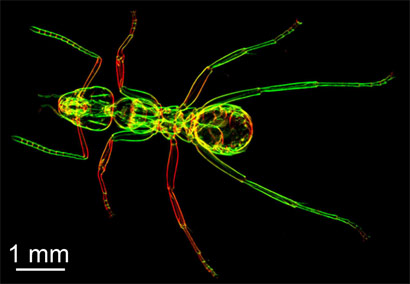- Home
- News
- General News
- Pioneer of imaging...
Pioneer of imaging techniques receives ESRF Young Scientist Award
10-02-2012
The Young Scientist of the Year Award 2012 was presented to Irene Zanette on 7 February, during the annual ESRF Users Meeting. Irene was chosen for the award for her work on “The development of a 2D grating interferometer for directional dark-field and quantitative phase imaging and for the demonstration of low-dose methods for multimodal grating-based tomography.” Laurence Margulies (BNL) presented Irene with the award on behalf of the ESRF Users Organisation.
Share
Irene was honoured at being chosen for the prize, “This prestigious prize means recognition of my work at the ESRF, for having installed a grating interferometer at ID19 and having significantly improved this technique”.
During the plenary session of the Users Meeting, Irene gave a presentation “X-ray grating interferometry at ESRF” to a packed auditorium. When asked about the benefits of her work, she replied, “The 2D grating interferometer significantly improves the quality of projection imaging by using information coming from both the quantitative phase image and the directional dark-field signal. This has tremendous potential for imaging soft tissue such as biological samples (e.g. mammography), in materials science for the imaging of cracks and regions with nanonoporosity and also for optics characterisation and wavefront sensing.”
Irene presented some of the spectacular images obtained with the new techniques that had already been highlighted by the ESRF. For example, the visualisation of brain tissues revealed individual cells called “Purkinje cells” (see: New insight into the human brain and Cellular insight into the human cerebellum by X-ray grating interferometry). Another example, shown below, is the dark field imaging of an ant, which permits internal structures to be made visible (Two-dimensional grating interferometer, ESRF Highlights 2011, p116-117).
The new techniques were developed at beamline ID19 while Irene was working on her thesis under the joint supervision of José Baruchel (ESRF) and Timm Weitkamp (now at Synchrotron Soleil). Her research involved a close collaboration with the groups of Franz Pfeiffer in Munich and Christian David at PSI. Having completed her PhD in 2011, Irene is now a postdoctoral researcher at Technische Universität München (Germany).
The Young Scientist of the Year Award is given every year by the ESRF Users Organisation at the ESRF Users Meeting for outstanding work done at the ESRF by a scientist 35 years of age or younger.
Top image: Lawrence Margulies (BNL) presenting the Young Scientist Award to Irene Zanette (TUM).




